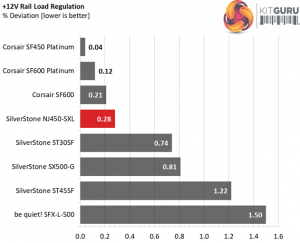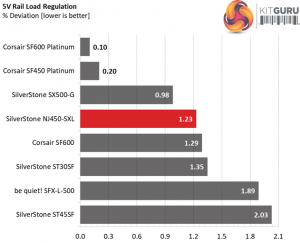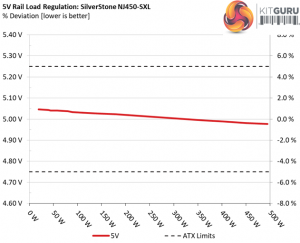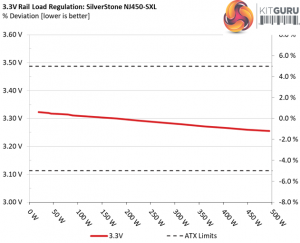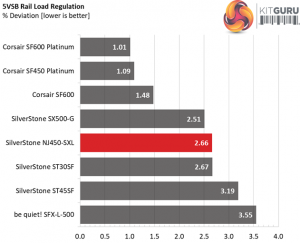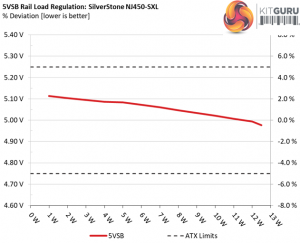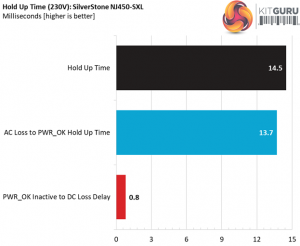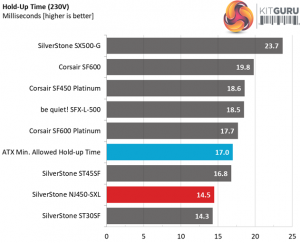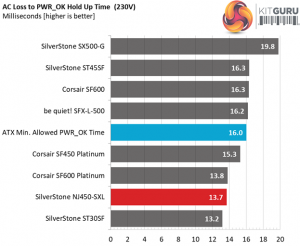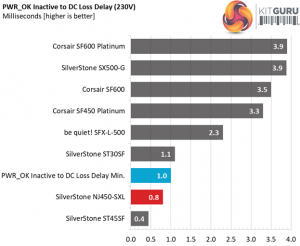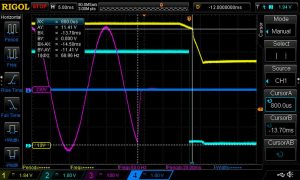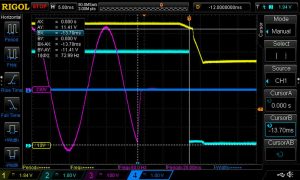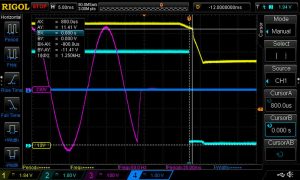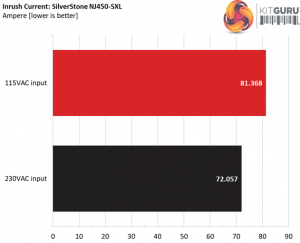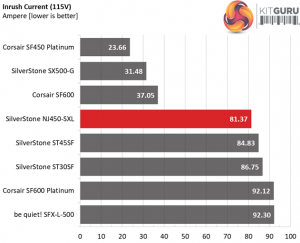To learn more about our PSU tests and methodology, please check out How We Test Power Supply Units.
Primary Rails And 5VSB Load Regulation
Load Regulation testing is detailed here.
Hold-Up Time
Our hold-up time tests are described in detail here.
The oscilloscope screenshots that we took during the hold-up time measurements:
The hold-up doesn't exceed 17ms, as the ATX spec dictates, however it is very close. Obviously there was no space available to install a larger bulk cap. On the bright side, the power ok signal is accurate.
Inrush Current
For details on our inrush current testing, please click here.
The inrush current is high with both voltage inputs.
Load Regulation And Efficiency Measurements
The first set of tests reveals the stability of the voltage rails and the NJ450-SXL’s efficiency. The applied load equals (approximately) 10 to 110 percent of the power supplies maximum load in increments of 10 percentage points.
We conducted two additional tests.
During the first, we stressed the two minor rails (5V and 3.3V) with a high load, while the load at +12V was only 0.1A. This test reveals whether a power supply is compatible with Intel's C6/C7 sleep states or not. In the second test, we determined the maximum load the +12V rail could handle with minimal load on the minor rails.
| Test # | 12V | 5V | 3.3V | 5VSB | DC/AC (Watts) | Efficiency | Fan Speed (RPM) | PSU Noise (dB[A]) | Temps Top/ Bottom |
PF/AC Volts |
| 1 | 1.941A | 1.985A | 1.989A | 0.984A | 44.879 | 82.690% | – | <6.0 | 43.50°C | 0.878 |
| 11.990V | 5.040V | 3.318V | 5.084V | 54.274 | 39.75°C | 115.32V | ||||
| 2 | 4.872A | 2.981A | 2.990A | 1.183A | 89.340 | 89.813% | – | <6.0 | 44.16°C | 0.943 |
| 11.994V | 5.034V | 3.311V | 5.072V | 99.473 | 40.06°C | 115.26V | ||||
| 3 | 8.212A | 3.482A | 3.477A | 1.384A | 134.467 | 91.673% | – | <6.0 | 45.46°C | 0.959 |
| 11.990V | 5.028V | 3.306V | 5.060V | 146.681 | 40.80°C | 115.20V | ||||
| 4 | 11.553A | 3.983A | 3.999A | 1.585A | 179.689 | 92.219% | – | <6.0 | 46.68°C | 0.961 |
| 11.987V | 5.023V | 3.300V | 5.047V | 194.851 | 41.62°C | 115.23V | ||||
| 5 | 14.562A | 4.986A | 5.009A | 1.788A | 224.988 | 92.324% | – | <6.0 | 47.49°C | 0.962 |
| 11.982V | 5.016V | 3.293V | 5.034V | 243.695 | 42.08°C | 115.16V | ||||
| 6 | 17.506A | 5.992A | 6.023A | 1.992A | 269.494 | 92.260% | – | <6.0 | 48.50°C | 0.962 |
| 11.978V | 5.009V | 3.286V | 5.021V | 292.104 | 42.84°C | 115.09V | ||||
| 7 | 20.521A | 7.000A | 7.044A | 2.197A | 314.810 | 91.743% | – | <6.0 | 49.37°C | 0.959 |
| 11.973V | 5.002V | 3.279V | 5.007V | 343.143 | 43.04°C | 115.04V | ||||
| 8 | 23.535A | 8.010A | 8.067A | 2.404A | 360.100 | 91.473% | – | <6.0 | 50.95°C | 0.962 |
| 11.969V | 4.995V | 3.272V | 4.994V | 393.668 | 44.26°C | 114.96V | ||||
| 9 | 26.953A | 8.523A | 8.571A | 2.407A | 405.001 | 91.231% | – | <6.0 | 52.13°C | 0.963 |
| 11.965V | 4.988V | 3.266V | 4.987V | 443.929 | 45.04°C | 114.99V | ||||
| 10 | 30.308A | 9.036A | 9.109A | 2.512A | 449.729 | 90.847% | – | <6.0 | 53.76°C | 0.964 |
| 11.961V | 4.982V | 3.260V | 4.977V | 495.038 | 45.87°C | 114.93V | ||||
| 11 | 34.064A | 9.045A | 9.127A | 2.516A | 494.535 | 90.353% | – | <6.0 | 54.72°C | 0.966 |
| 11.957V | 4.977V | 3.255V | 4.971V | 547.339 | 46.48°C | 114.86V | ||||
| CL1 | 0.137A | 10.003A | 10.001A | 0.000A | 84.853 | 87.793% | – | <6.0 | 50.00°C | 0.944 |
| 11.997V | 5.019V | 3.300V | 5.095V | 96.651 | 43.89°C | 115.26V | ||||
| CL2 | 37.511A | 1.002A | 0.999A | 1.000A | 462.176 | 91.585% | – | <6.0 | 53.90°C | 0.964 |
| 11.966V | 5.001V | 3.275V | 5.036V | 504.639 | 45.79°C | 114.92V |
The NJ450-SXL does not have any problem, at all, to deliver its full power and even more under extremely tough conditions.
We cranked up the heat inside our hotbox up to 46.5°C and the power supply operated without problems, delivering high efficiency levels. This is a great platform which looks to deliver half of its nominal power in order to be able to cope with the lack of active cooling.
The load regulation at +12V is tight, while at 5V and 3.3V is within the 2% range, so it is satisfactory. Finally, the 5VSB rail stays in the 3% range.
 KitGuru KitGuru.net – Tech News | Hardware News | Hardware Reviews | IOS | Mobile | Gaming | Graphics Cards
KitGuru KitGuru.net – Tech News | Hardware News | Hardware Reviews | IOS | Mobile | Gaming | Graphics Cards


